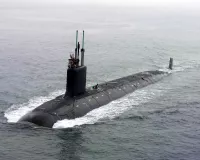Lockheed Martin is a global American aerospace, arms, defense, information security, and technology corporation. It was formed in 1995 through the merger of Lockheed Corporation and Martin Marietta and is headquartered in North Bethesda, Maryland. A large employer with around 121,000 employees worldwide, a significant portion of whom are engineers and scientists, Lockheed Martin operates in a sector that demands highly skilled labor and generates substantial revenue. Lockheed Martin has a market capitalization of approximately $139.7 billion as of 2024.
1984: First free-flying spacewalk using a Lockheed Martin jetpack
In 1984, Bruce McCandless II, a former Lockheed Martin employee, performed the first free-flying spacewalk without a lifeline to the orbiting shuttle, using a jetpack built by Lockheed Martin.
1993: Acquisition of Sandia National Laboratories Management Contract
In 1993, Martin Marietta acquired the management contract for Sandia National Laboratories, adding to its portfolio of technological and scientific ventures.
March 1994: Merger Talks Begin
In March 1994, merger discussions commenced between Lockheed Corporation and Martin Marietta, leading to a significant consolidation in the defense industry.
August 30, 1994: Planned Merger Announced
On August 30, 1994, Lockheed Corporation and Martin Marietta publicly announced their planned merger, valued at $10 billion, to create a combined defense company.
March 15, 1995: Merger Finalized
On March 15, 1995, the merger between Lockheed Corporation and Martin Marietta was finalized after shareholder approval, leading to the formation of Lockheed Martin.
March 1995: Lockheed Martin formed by merger
In March 1995, Lockheed Martin was officially formed through the merger of Lockheed Corporation and Martin Marietta, creating a major defense and aerospace manufacturer.
1995: Settlements for Misconduct Since 1995
Since 1995, Lockheed Martin has agreed to pay $676.8 million to settle 88 instances of misconduct.
April 22, 1996: Acquisition of Loral Corporation's Defense Electronics
On April 22, 1996, Lockheed Martin finalized the acquisition of Loral Corporation's defense electronics and system integration businesses for $9.1 billion, expanding its capabilities in these areas.
July 16, 1998: Merger with Northrop Grumman Abandoned
On July 16, 1998, Lockheed Martin abandoned its $8.3 billion merger plans with Northrop Grumman due to government concerns about the potential dominance of the combined entity in the defense sector.
1998: Start of Tools & Metals Inc's Inflation of Costs
Between 1998 and 2005, Lockheed Martin passed on inflated costs from Tools & Metals Inc to the U.S. government under its contracts.
November 27, 2000: Sale of Aerospace Electronic Systems Business
On November 27, 2000, Lockheed Martin completed the sale of its Aerospace Electronic Systems business to BAE Systems for $1.67 billion, a deal that included Sanders Associates, Fairchild Systems, and Lockheed Martin Space Electronics & Communications.
May 2001: Sale of Lockheed Martin Control Systems to BAE Systems
In May 2001, Lockheed Martin sold Lockheed Martin Control Systems to BAE Systems as part of its strategic business adjustments.
2001: Collier Trophy Award
In 2001, Lockheed Martin received the Collier Trophy for its contribution to developing the X-35/F-35B LiftFan Propulsion System.
July 8, 2003: Mass Shooting at Lockheed Martin Plant
On July 8, 2003, a racially motivated mass shooting occurred at a Lockheed Martin plant in Meridian, Mississippi, resulting in six deaths and eight injuries before the perpetrator took his own life. This event raised questions about workplace safety and employee relations within the company.
2004: Challenges with Employee Retirement
In 2004, Robert Stevens, upon taking control of Lockheed Martin, was confronted with the issue that 100,000 of the company's approximately 130,000 employees were nearing retirement within the next decade.
2005: End of Tools & Metals Inc's Inflation of Costs
Between 1998 and 2005, Lockheed Martin passed on inflated costs from Tools & Metals Inc to the U.S. government under its contracts.
March 2006: Sentencing of Former TMI President
In March 2006, Todd B. Loftis, a former TMI president, was sentenced to 87 months in prison and ordered to pay a fine of $20 million following his guilty plea.
May 12, 2006: Report on Impending Retirements
On May 12, 2006, The Washington Post reported that Lockheed Martin was facing a challenge with a large portion of its workforce nearing retirement.
August 31, 2006: NASA Contract for CEV Capsule
On August 31, 2006, NASA awarded Lockheed Martin a $3.9 billion contract to design and build the CEV capsule, later named Orion, for the Ares I rocket in the Constellation Program.
August 2007: Acquisition of 3Dsolve
In August 2007, Lockheed Martin acquired 3Dsolve, a Cary, North Carolina-based company specializing in simulations and training modules for military and corporate clients, later renamed Lockheed Martin 3D Solutions.
August 13, 2008: Acquisition of Nantero's Government Business Unit
On August 13, 2008, Lockheed Martin acquired the government business unit of Nantero, Inc., a company known for developing carbon nanotube technology for next-generation electronics, expanding its capabilities in advanced materials and electronics.
2008: Lockheed Martin Received 36 Billion in Government Contracts
In 2008 alone, Lockheed Martin received $36 billion in government contracts, more than any company in history, for work spanning over two dozen government agencies.
2009: Acquisition of Unitech
In 2009, Lockheed Martin expanded its business portfolio with the acquisition of Unitech.
2009: Government Contracts Revenue
In 2009, Lockheed Martin's revenue sources were US government contracts ($38.4 billion, 85%), foreign government contracts ($5.8 billion, 13%), and commercial/other contracts ($900 million, 2%).
2009: Lobbying Expenditure
Lockheed Martin's 2009 lobbying expenditure is $13.7 million.
November 18, 2010: Closure of Eagan, Minnesota Location
On November 18, 2010, Lockheed Martin announced its decision to close its Eagan, Minnesota facility by 2013 as part of a cost-reduction and capacity optimization strategy.
January 2011: Largest Contributor to House Armed Services Committee Chairman
As of January 2011, Lockheed Martin was the largest contributor to the House Armed Services Committee chairman, Republican Buck McKeon of California with over $50,000 donated in the election cycle.
January 2011: Settlement for False Claims Allegations
In January 2011, Lockheed Martin agreed to pay the U.S. Government $2 million to resolve allegations of submitting false claims on a government contract related to the Naval Oceanographic Office Major Shared Resource Center in Mississippi.
May 25, 2011: Purchase of Quantum Computing System
On May 25, 2011, Lockheed Martin acquired the first Quantum Computing System from D-Wave Systems, initiating a collaboration to explore the application of quantum annealing processors to complex computational problems.
May 28, 2011: Cyberattack on Lockheed Martin
On May 28, 2011, reports emerged of a cyberattack on Lockheed Martin, where previously stolen EMC files were used to penetrate sensitive materials. This event highlighted the increasing cybersecurity threats faced by defense contractors.
June 1, 2011: New U.S. Military Cyberattack Strategy
On June 1, 2011, the United States announced a new military strategy, explicitly stating that a cyberattack could be considered a casus belli, potentially triggering a traditional act of war. This announcement may or may not be related to the May 28th cyber attack on Lockheed Martin.
March 3, 2012: Settlement of Overpriced Tools Allegations
On March 3, 2012, the U.S. Department of Justice (DOJ) said that Lockheed Martin had agreed to settle allegations that the defense contractor had sold overpriced perishable tools used on many contracts.
July 10, 2012: Workforce Reduction Announced
On July 10, 2012, Lockheed Martin announced plans to reduce its workforce by 740 positions as a cost-cutting measure to maintain competitiveness and facilitate future growth.
November 27, 2012: Marillyn Hewson Appointed CEO
On November 27, 2012, Lockheed Martin announced that Marillyn Hewson would assume the role of chief executive officer, effective January 1, 2013.
2012: Top Donor to Senate Appropriations Committee Chair
Prior to his death in 2012, Lockheed Martin was the top donor to Sen. Daniel Inouye (D-HI), the chair of the Senate Appropriations Committee.
January 1, 2013: Marillyn Hewson Becomes CEO
On January 1, 2013, Marillyn Hewson officially took office as the chief executive officer of Lockheed Martin, succeeding her predecessor.
January 7, 2013: Acquisition of Aveos Fleet Performance Assets
On January 7, 2013, Lockheed Martin Canada announced its acquisition of engine maintenance, repair, and overhaul assets from Aveos Fleet Performance in Montreal, Quebec, Canada, enhancing its aerospace service capabilities.
February 20, 2013: Settlement of Securities Fraud Lawsuit
On February 20, 2013, Lockheed Martin Corp complied with the United States District Court for the Southern District of New York, agreeing to pay a $19.5 million lawsuit to conclude a securities fraud class-action legal battle that had accused the company of deceiving shareholders in regards to expectations for the company's information technology division.
July 3, 2013: Partnership with DreamHammer
On July 3, 2013, Lockheed Martin announced a partnership with DreamHammer to integrate the company's software for command and control of its unmanned aerial vehicles, enhancing its capabilities in unmanned systems.
September 2013: Acquisition of Amor Group
In September 2013, Lockheed Martin acquired Amor Group, a technology firm based in Scotland, to support its expansion into international and non-defense markets.
October 2013: Expected Finalization of $2.2 Billion Contract with USAF
In October 2013, Lockheed announced it expected to finalize a $2.2 billion contract with the United States Air Force for two advanced military communications satellites.
November 14, 2013: Closure of Akron, Ohio Facility
On November 14, 2013, Lockheed Martin announced the closure of its Akron, Ohio facility, resulting in the layoff of 500 employees and the transfer of others to different locations.
2013: Closure of Eagan Location
In 2013, Lockheed Martin completed the closure of its Eagan, Minnesota, location as previously announced in 2010, as part of cost-reduction efforts.
2013: Criticism of the F-35 Fighter Program
In 2013, Lt. Gen. Christopher Bogdan criticized Lockheed Martin's F-35 fighter program, calling for greater investment in cost reductions and risk-sharing.
2013: Military Sales Revenue
In 2013, military sales accounted for 78% of Lockheed Martin's revenues, making it the top US federal government contractor and recipient of nearly 10% of Pentagon funds.
March 2014: Acquisition of Beontra AG and Industrial Defender Inc.
In March 2014, Lockheed Martin acquired Beontra AG, a provider of planning and forecasting tools for airports, and Industrial Defender Inc., expanding its business in commercial airport technology and industrial cybersecurity solutions.
June 2, 2014: Pentagon Contract for Space Fence
On June 2, 2014, Lockheed Martin was awarded a Pentagon contract to construct a space fence capable of tracking debris in space to protect satellites and spacecraft from damage.
December 20, 2014: Settlement of False Claims Act Lawsuit
On December 20, 2014, Lockheed Martin Integrated Systems agreed to settle a False Claims Act lawsuit paying $27.5 million to finalize allegations that it had knowingly overbilled taxpayers for work performed by company staff who did not hold the relevant essential qualifications for the contract.
2014: Largest Defense Contractor by Revenue
In fiscal year 2014, Lockheed Martin was the world's largest defense contractor by revenue.
March 31, 2015: US Navy Contract for Freedom-class Ships
On March 31, 2015, the US Navy awarded Lockheed Martin a $362 million contract for the construction of Freedom-class ship LCS 21 and $79 million for advance procurement for LCS 23.
July 20, 2015: Plans to Purchase Sikorsky Aircraft
On July 20, 2015, Lockheed Martin announced its plans to acquire Sikorsky Aircraft from United Technologies Corporation for $7.1 billion, a move later criticized by the Pentagon for potentially reducing competition.
November 2015: Acquisition of Sikorsky Aircraft Approved
In November 2015, the Chinese government granted final approval for Lockheed Martin's acquisition of Sikorsky Aircraft, with a total cost of $9 billion, marking a significant expansion in Lockheed Martin's aerospace portfolio.
December 2015: Contract to Train Australian Military Pilots
In December 2015, Lockheed Martin secured an $867 million contract spanning seven years to provide training for Australia's next generation of military pilots, with the option for a 26-year extension, significantly increasing the deal's potential value.
August 2016: Maritime Combat System Tested
In August 2016, Canadian Forces Maritime conducted tests on an integrated submarine combat system developed by Lockheed Martin, marking Canada's first utilization of the combat system with the MK 48 heavyweight torpedo, variant 7AT.
May 2017: Business Deals with Saudi Arabia
In May 2017, during President Donald Trump's visit to Saudi Arabia, the country entered into business agreements with U.S. companies, including Lockheed Martin, worth tens of billions of dollars as part of the 2017 United States–Saudi Arabia arms deal.
April 2018: Air Force Hypersonic Weapons Contract
In April 2018, Lockheed Martin secured its first contract from the Air Force, valued at $928 million, for the development of hypersonic weapons.
August 13, 2018: Hypersonic Weapon Contract from US Air Force
On August 13, 2018, Lockheed Martin secured a $480 million contract from the United States Air Force to develop a hypersonic weapon prototype, which can travel at one mile per second.
November 29, 2018: Commercial Lunar Payload Services contract awarded by NASA
On November 29, 2018, NASA awarded Lockheed Martin a Commercial Lunar Payload Services contract. The contract made Lockheed Martin eligible to bid on delivering science and technology payloads to the Moon for NASA, worth $2.6 billion.
2018: Discovery of a large number of defects in F-35 fighter jets
In 2018 reviews revealed a large number of defects in Lockheed Martin's F-35 fighter jets.
2018: Collier Trophy Award for Auto-GCAS
In 2018, Lockheed Martin was awarded the Collier Trophy for the Automatic Ground Collision Avoidance System (Auto-GCAS).
2018: Lockheed Martin Ranked Number 59 in Fortune 500
Lockheed Martin's backlog was 130.5 billion at the end of 2018 and ranked number 59 in the Fortune 500 list.
April 11, 2019: Successful launch of Arabsat-6A satellite
On April 11, 2019, the Arabsat-6A satellite, one of the most advanced commercial communications satellites built by Lockheed Martin, was successfully launched from LC-39A at 6:35 pm EDT.
September 23, 2019: Contract to build Orion capsules for NASA's Artemis program
On September 23, 2019, Lockheed Martin and NASA signed a $4.6-billion contract to build six or more Orion capsules for NASA's Artemis program, which aimed to send astronauts to the Moon.
2019: Lockheed Martin Backlog and Firm Orders at the End of 2019
By the end of 2019, Lockheed Martin's backlog was 144.0 billion and firm orders were $94.5 billion, with shares trading at over $389 per share and a market capitalization valued at US$109.83 billion.
2019: Discovery of a large number of defects in F-35 fighter jets
In 2019 reviews revealed a large number of defects in Lockheed Martin's F-35 fighter jets.
January 2020: Naval Sea Systems Command awards Lockheed Martin contract for AEGIS Combat System Engineering Agent
In January 2020, the Naval Sea Systems Command awarded Lockheed Martin a $138 million contract related to the AEGIS Combat System Engineering Agent (CSEA).
January 2020: Discovery of software defects in F-35 fighter jets
In January 2020, the Pentagon found at least 800 software defects in Lockheed Martin's F-35 fighter jets owned by the US Armed Forces during an annual review.
February 2020: Acquisition of GalacticSky satellite software technology
In February 2020, Lockheed Martin acquired Vector Launch Inc's satellite software technology GalacticSky for $4.25 million.
March 16, 2020: Announcement of James D. Taiclet as new CEO
On March 16, 2020, Lockheed Martin announced that James D. Taiclet would replace Marillyn Hewson as CEO, with the change effective June 15.
July 2020: Sanctioned by Chinese government
Lockheed Martin was sanctioned by the Chinese government in July 2020 due to arm sales to Taiwan.
October 2020: Sanctioned by Chinese government
Lockheed Martin was sanctioned by the Chinese government again in October 2020 due to arm sales to Taiwan.
December 2020: Expected completion of AEGIS project
The AEGIS project, awarded in January 2020, was expected to be completed by December 2020.
December 20, 2020: Announcement of acquisition of Aerojet Rocketdyne Holdings
On December 20, 2020, it was announced that Lockheed Martin would acquire Aerojet Rocketdyne Holdings for $4.4 billion, with the acquisition expected to close in the first quarter of 2022.
2020: Board of Directors
As of 2020, the board of directors consists of 14 members.
2020: Lockheed Martin reports earnings for fiscal year 2020
For the fiscal year 2020, Lockheed Martin reported earnings of $6.833 billion, with an annual revenue of $65.398 billion, an increase of 9.3% over the previous year.
2021: Taiclet became chairman of the company
In January of 2021, James Taiclet became chairman of Lockheed Martin.
January 2022: Lockheed Martin employs 121,000 worldwide
As of January 2022, Lockheed Martin's workforce comprised approximately 121,000 employees worldwide, including around 60,000 engineers and scientists.
February 13, 2022: Lockheed abandons deal to acquire Aerojet Rocketdyne Holdings
On February 13, 2022, Lockheed abandoned the deal to acquire Aerojet Rocketdyne Holdings following regulatory disapproval.
2022: Increase in sales and profits during Russian invasion of Ukraine
In 2022, during the Russian invasion of Ukraine, major arms manufacturers, including Lockheed Martin, reported a sharp increase in interim sales and profits.
2022: Lobbying Expenditure
Lockheed Martin's 2022 lobbying expenditure is $13.6 million.
February 2023: Sanctioned by Chinese government
Lockheed Martin was sanctioned by the Chinese government in February 2023 due to arm sales to Taiwan.
May 2023: Formation of microelectronics subsidiary ForwardEdge ASIC
In May 2023, Lockheed formed a new microelectronics subsidiary ForwardEdge ASIC to design custom application-specific integrated circuits for its customers.
November 2023: Direct action taken against arms companies
In November 2023, attempts at Direct action were taken against arms companies in the United States and the United Kingdom, including Lockheed Martin, that supplied weapons to Israel during the 2023 Israel–Hamas war.
December 2023: Main Holders of Lockheed Martin Shares
As of December 2023, Lockheed Martin shares are mainly held by institutional investors (State Street Corporation, Vanguard group, BlackRock, Capital Group Companies, and others).
March 2024: Bid to acquire Terran Orbital
In March 2024, Lockheed Martin submitted a bid to acquire Terran Orbital.
June 28, 2024: $4.5 Billion Contract for Patriot Advanced Capability-3 (PAC-3) Missiles
On June 28, 2024, the U.S. Army awarded Lockheed Martin a $4.5 billion contract to supply Patriot Advanced Capability-3 (PAC-3) missiles, including 870 PAC-3 MSE missiles and related hardware.
October 9, 2024: Appointment of Chauncey McIntosh as VP and General Manager of F-35 Program
On October 9, 2024, Lockheed Martin announced the appointment of Chauncey McIntosh as vice president and general manager of the F-35 Lightning II Program, effective December 1, 2024.
December 1, 2024: Chauncey McIntosh Appointed VP and General Manager of F-35 Program
On December 1, 2024, Chauncey McIntosh became the vice president and general manager of the F-35 Lightning II Program, succeeding Bridget Lauderdale.
December 2024: Formation of Astris AI Subsidiary
In December 2024, Lockheed Martin announced that it had formed a subsidiary, Astris AI, that would help U.S. defense companies to incorporate artificial intelligence into their operations.
2024: Market Cap Estimate
Reports from 2024 estimate that Lockheed Martin Corporation (LMT) holds a market cap of around $139.7 billion.
2025: Military Aim to Reach 25% Renewable Energy
Lockheed Martin helps the military transition to renewable energy sources with solar photovoltaic powered microgrids as the military aims to reach 25% renewable energy by 2025 in order to improve national security.
Mentioned in this timeline

Donald John Trump is an American politician media personality and...
Ukraine is a large country in Eastern Europe second in...
The United States of America is a federal republic located...
California is a U S state on the Pacific Coast...
Saudi Arabia officially the Kingdom of Saudi Arabia KSA is...

A submarine is a watercraft capable of independent operation underwater...
Trending

5 months ago New Bay Area Sex Podcast 'SlutStack', Cindy Crawford's Mornings, and Actors' Pay Discussed

2 months ago Gwyneth Paltrow on Timothée Chalamet and Kylie Jenner's Relationship: 'Punk Rock'

Simu Liu is a Canadian actor best known for his role as Shang-Chi in Marvel's Shang-Chi and the Legend of...

12 days ago Hugh Jackman & Kate Hudson surprise NYC bar with Neil Diamond tribute.

7 months ago Deborra-Lee Furness files for divorce from Hugh Jackman amidst Sutton Foster affair rumors.

Artie Lange is an American stand-up comedian actor and radio personality He is most famous for his roles on Mad...
Popular

Candace Owens is an American conservative political commentator and author...

Ilhan Omar is an American politician currently serving as the...

XXXTentacion born Jahseh Dwayne Ricardo Onfroy was a controversial yet...

Tom Cotton is an American politician and Army veteran currently...

Oprah Winfrey an American talk show host television producer actress...
Matt and Ross Duffer known as the Duffer Brothers are...